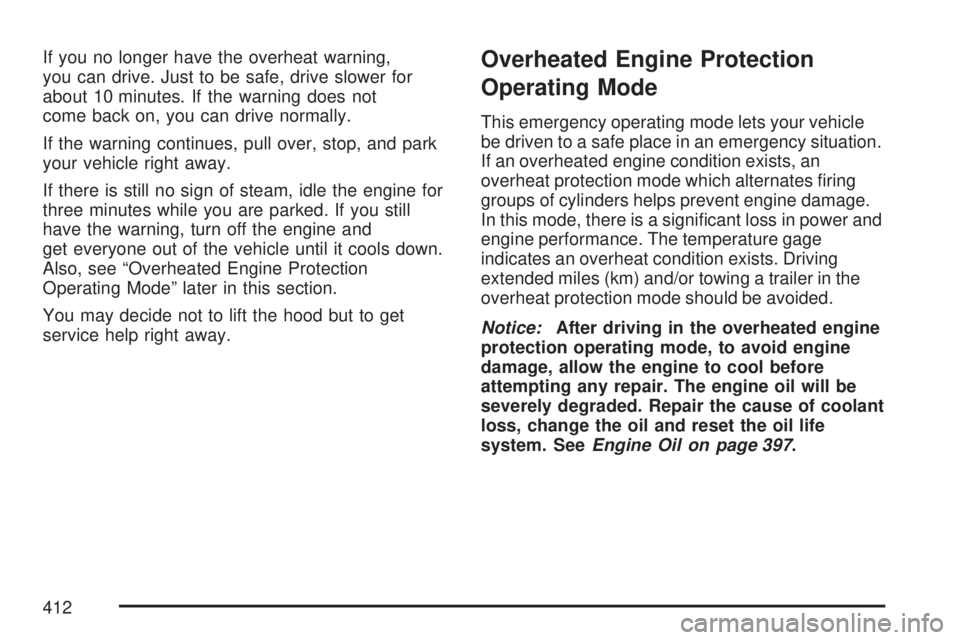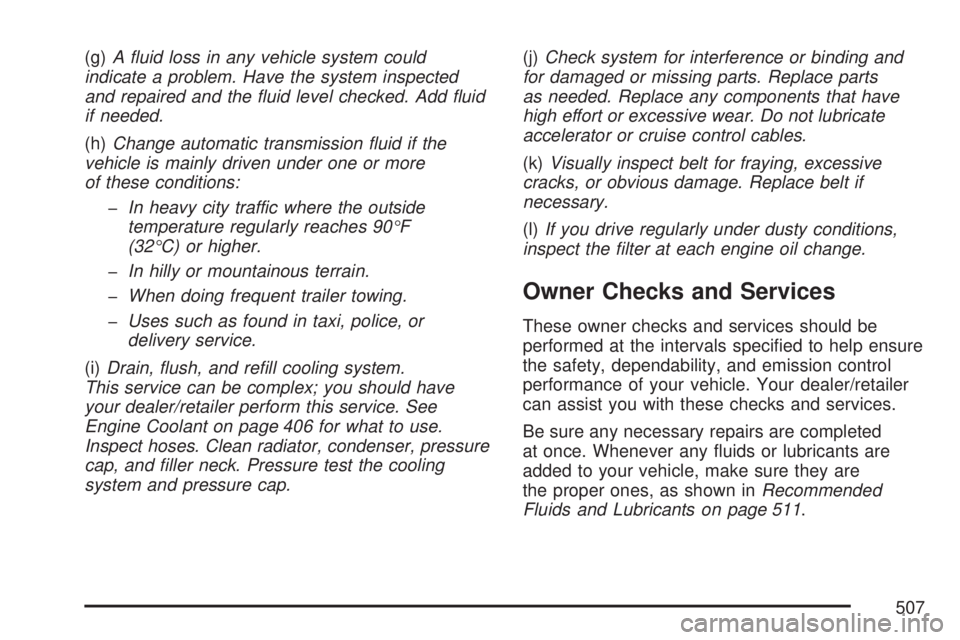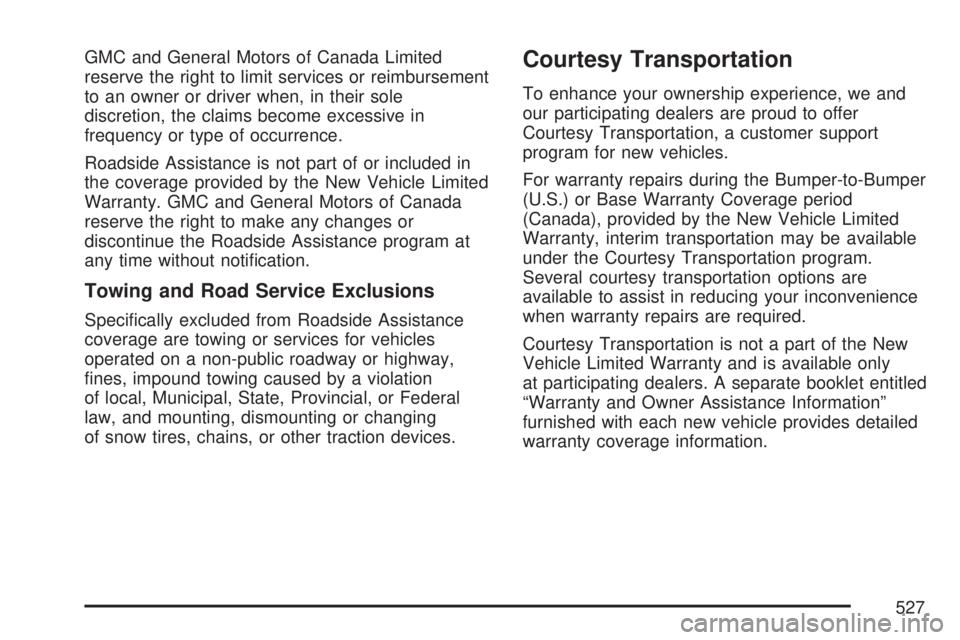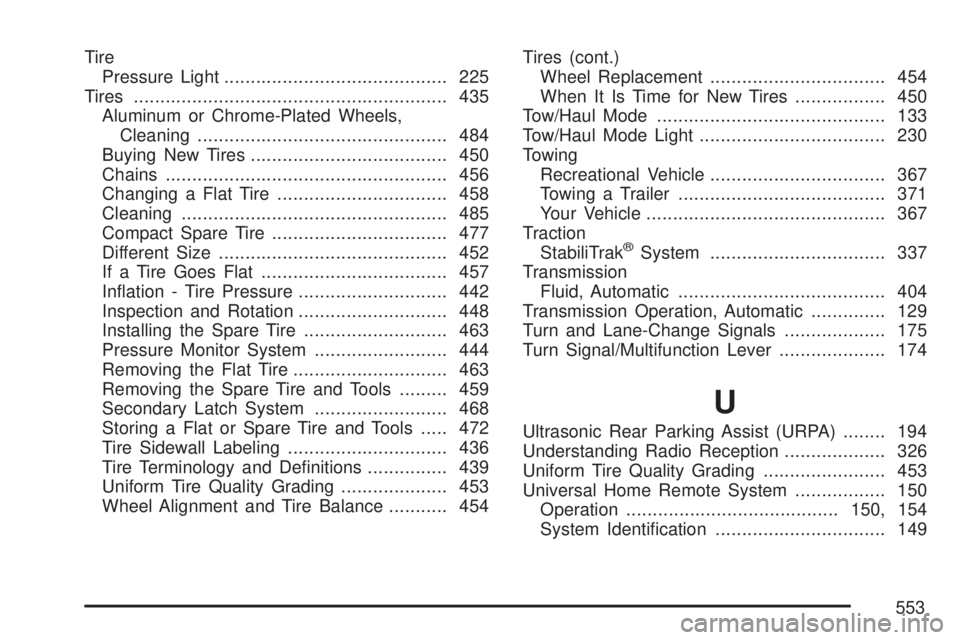2007 GMC ACADIA towing
[x] Cancel search: towingPage 388 of 554

Gasoline Octane
Use regular unleaded gasoline with a posted
octane rating of 87 or higher. For best performance
or trailer towing, you could choose to use middle
grade 89 octane unleaded gasoline. If the
octane rating is less than 87, you might notice
an audible knocking noise when you drive,
commonly referred to as spark knock. If this
occurs, use a gasoline rated at 87 octane or higher
as soon as possible. If you are using gasoline
rated at 87 octane or higher and you hear heavy
knocking, the engine needs service.
Gasoline Speci�cations
At a minimum, gasoline should meet ASTM
speci�cation D 4814 in the United States or
CAN/CGSB-3.5 or 3.511 in Canada. Some
gasolines contain an octane-enhancing additive
called methylcyclopentadienyl manganese
tricarbonyl (MMT). We recommend against the
use of gasolines containing MMT. SeeAdditives
on page 389for additional information.
California Fuel
If your vehicle is certi�ed to meet California
Emissions Standards, it is designed to operate
on fuels that meet California speci�cations.
See the underhood emission control label.
If this fuel is not available in states adopting
California emissions standards, your vehicle will
operate satisfactorily on fuels meeting federal
speci�cations, but emission control system
performance might be affected. The malfunction
indicator lamp could turn on and your vehicle might
fail a smog-check test. SeeMalfunction Indicator
Lamp on page 226. If this occurs, return to
your authorized dealer/retailer for diagnosis.
If it is determined that the condition is caused
by the type of fuel used, repairs might not
be covered by your warranty.
388
Page 412 of 554

If you no longer have the overheat warning,
you can drive. Just to be safe, drive slower for
about 10 minutes. If the warning does not
come back on, you can drive normally.
If the warning continues, pull over, stop, and park
your vehicle right away.
If there is still no sign of steam, idle the engine for
three minutes while you are parked. If you still
have the warning, turn off the engine and
get everyone out of the vehicle until it cools down.
Also, see “Overheated Engine Protection
Operating Mode” later in this section.
You may decide not to lift the hood but to get
service help right away.Overheated Engine Protection
Operating Mode
This emergency operating mode lets your vehicle
be driven to a safe place in an emergency situation.
If an overheated engine condition exists, an
overheat protection mode which alternates �ring
groups of cylinders helps prevent engine damage.
In this mode, there is a signi�cant loss in power and
engine performance. The temperature gage
indicates an overheat condition exists. Driving
extended miles (km) and/or towing a trailer in the
overheat protection mode should be avoided.
Notice:After driving in the overheated engine
protection operating mode, to avoid engine
damage, allow the engine to cool before
attempting any repair. The engine oil will be
severely degraded. Repair the cause of coolant
loss, change the oil and reset the oil life
system. SeeEngine Oil on page 397.
412
Page 507 of 554

(g)A fluid loss in any vehicle system could
indicate a problem. Have the system inspected
and repaired and the fluid level checked. Add fluid
if needed.
(h)Change automatic transmission fluid if the
vehicle is mainly driven under one or more
of these conditions:
�In heavy city traffic where the outside
temperature regularly reaches 90°F
(32°C) or higher.
�In hilly or mountainous terrain.
�When doing frequent trailer towing.
�Uses such as found in taxi, police, or
delivery service.
(i)Drain, flush, and refill cooling system.
This service can be complex; you should have
your dealer/retailer perform this service. See
Engine Coolant on page 406 for what to use.
Inspect hoses. Clean radiator, condenser, pressure
cap, and filler neck. Pressure test the cooling
system and pressure cap.(j)Check system for interference or binding and
for damaged or missing parts. Replace parts
as needed. Replace any components that have
high effort or excessive wear. Do not lubricate
accelerator or cruise control cables.
(k)Visually inspect belt for fraying, excessive
cracks, or obvious damage. Replace belt if
necessary.
(l)If you drive regularly under dusty conditions,
inspect the filter at each engine oil change.
Owner Checks and Services
These owner checks and services should be
performed at the intervals speci�ed to help ensure
the safety, dependability, and emission control
performance of your vehicle. Your dealer/retailer
can assist you with these checks and services.
Be sure any necessary repairs are completed
at once. Whenever any �uids or lubricants are
added to your vehicle, make sure they are
the proper ones, as shown inRecommended
Fluids and Lubricants on page 511.
507
Page 527 of 554

GMC and General Motors of Canada Limited
reserve the right to limit services or reimbursement
to an owner or driver when, in their sole
discretion, the claims become excessive in
frequency or type of occurrence.
Roadside Assistance is not part of or included in
the coverage provided by the New Vehicle Limited
Warranty. GMC and General Motors of Canada
reserve the right to make any changes or
discontinue the Roadside Assistance program at
any time without noti�cation.
Towing and Road Service Exclusions
Speci�cally excluded from Roadside Assistance
coverage are towing or services for vehicles
operated on a non-public roadway or highway,
�nes, impound towing caused by a violation
of local, Municipal, State, Provincial, or Federal
law, and mounting, dismounting or changing
of snow tires, chains, or other traction devices.
Courtesy Transportation
To enhance your ownership experience, we and
our participating dealers are proud to offer
Courtesy Transportation, a customer support
program for new vehicles.
For warranty repairs during the Bumper-to-Bumper
(U.S.) or Base Warranty Coverage period
(Canada), provided by the New Vehicle Limited
Warranty, interim transportation may be available
under the Courtesy Transportation program.
Several courtesy transportation options are
available to assist in reducing your inconvenience
when warranty repairs are required.
Courtesy Transportation is not a part of the New
Vehicle Limited Warranty and is available only
at participating dealers. A separate booklet entitled
“Warranty and Owner Assistance Information”
furnished with each new vehicle provides detailed
warranty coverage information.
527
Page 532 of 554

If your vehicle cannot be driven, know where
the towing service will be taking it. Get a
card from the tow truck operator or write down
the driver’s name, the service’s name, and
the phone number.
Remove any valuables from your vehicle before
it is towed away. Make sure this includes your
insurance information and registration if you
keep these items in your vehicle.
Gather the important information you will need
from the other driver. Things like name,
address, phone number, driver’s license
number, vehicle license plate, vehicle make,
model and model year, Vehicle Identi�cation
Number (VIN), insurance company and policy
number, and a general description of the
damage to the other vehicle.
If possible, call your insurance company from
the scene of the accident. They will walk you
through the information they will need. If they
ask for a police report, phone or go to the police
department headquarters the next day and you
can get a copy of the report for a nominal fee. In
some states/provinces with “no fault” insurance
laws, a report may not be necessary. This is
especially true if there are no injuries and both
vehicles are driveable.
Choose a reputable collision repair facility for
your vehicle. Whether you select a dealer/
retailer or a private collision repair facility to �x
the damage, make sure you are comfortable
with them. Remember, you will have to feel
comfortable with their work for a long time.
Once you have an estimate, read it carefully
and make sure you understand what work will
be performed on your vehicle. If you have a
question, ask for an explanation. Reputable
shops welcome this opportunity.
532
Page 550 of 554

Q
Questions and Answers About Safety Belts.... 28
R
Radiator Pressure Cap................................ 410
Radio Frequency Identi�cation (RFID),
Privacy..................................................... 538
Radios........................................................ 264
Care of Your CD and DVD Player............ 328
Care of Your CDs and DVDs................... 328
Navigation/Radio System,
see Navigation Manual......................... 311
Radio with CD......................................... 268
Radio with CD and DVD.......................... 278
Rear Audio Controller (RAC).................... 324
Rear Seat Audio...................................... 322
Setting the Time...................................... 266
Theft-Deterrent......................................... 325
Understanding Reception......................... 326
Reading Lamps........................................... 188
Rear Air Conditioning and Heating System ... 211
Rear Air Conditioning and Heating System
and Electronic Climate Controls............... 212
Rear Audio Controller (RAC)....................... 324Rear Door Security Locks........................... 108
Rear Safety Belt Comfort Guides.................. 43
Rear Seat Armrest...................................... 163
Rear Seat Audio (RSA)............................... 322
Rear Seat Entertainment System................. 311
Rear Seat Operation..................................... 18
Rear Seat Passengers, Safety Belts.............. 40
Rear Windshield Washer/Wiper.................... 179
Rearview Mirror, Automatic Dimming
with OnStar
®and Compass..................... 140
Rearview Mirror with OnStar®...................... 140
Reclining Seatbacks...................................... 15
Recommended Fluids and Lubricants.......... 511
Recreational Vehicle Towing........................ 367
Remote Keyless Entry (RKE) System............ 98
Remote Keyless Entry (RKE) System,
Operation................................................. 100
Removing the Flat Tire and
Installing the Spare Tire........................... 463
Removing the Spare Tire and Tools............ 459
Replacement Bulbs..................................... 433
Reporting Safety Defects
Canadian Government............................. 534
General Motors........................................ 534
United States Government....................... 533
550
Page 553 of 554

Tire
Pressure Light.......................................... 225
Tires........................................................... 435
Aluminum or Chrome-Plated Wheels,
Cleaning............................................... 484
Buying New Tires..................................... 450
Chains..................................................... 456
Changing a Flat Tire................................ 458
Cleaning.................................................. 485
Compact Spare Tire................................. 477
Different Size........................................... 452
If a Tire Goes Flat................................... 457
In�ation - Tire Pressure............................ 442
Inspection and Rotation............................ 448
Installing the Spare Tire........................... 463
Pressure Monitor System......................... 444
Removing the Flat Tire............................. 463
Removing the Spare Tire and Tools......... 459
Secondary Latch System......................... 468
Storing a Flat or Spare Tire and Tools..... 472
Tire Sidewall Labeling.............................. 436
Tire Terminology and De�nitions............... 439
Uniform Tire Quality Grading.................... 453
Wheel Alignment and Tire Balance........... 454Tires (cont.)
Wheel Replacement................................. 454
When It Is Time for New Tires................. 450
Tow/Haul Mode........................................... 133
Tow/Haul Mode Light................................... 230
Towing
Recreational Vehicle................................. 367
Towing a Trailer....................................... 371
Your Vehicle............................................. 367
Traction
StabiliTrak
®System................................. 337
Transmission
Fluid, Automatic....................................... 404
Transmission Operation, Automatic.............. 129
Turn and Lane-Change Signals................... 175
Turn Signal/Multifunction Lever.................... 174
U
Ultrasonic Rear Parking Assist (URPA)........ 194
Understanding Radio Reception................... 326
Uniform Tire Quality Grading....................... 453
Universal Home Remote System................. 150
Operation........................................150, 154
System Identi�cation................................ 149
553